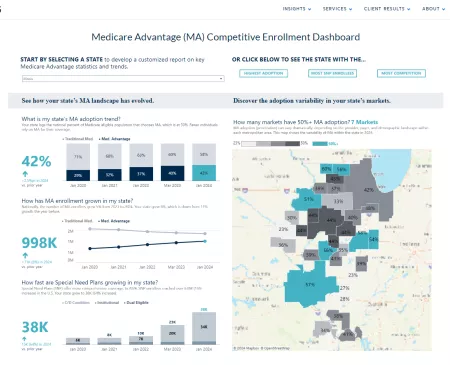Core to many private equity funds' investment theses is the ability to ride favorable industry tailwinds while reinventing under-professionalized but historically reliable business models. Over time, the collective transformation and subsequent consolidation of businesses in a sector drive industry maturation. Across many healthcare sectors, we see common patterns of industry maturation, ranging from novel businesses to decades-old models. Each sector of healthcare moves at its own pace but along a common maturity curve unique to the industry.
Industry maturity curves are nothing new. However, in healthcare services, the business lifecycle looks a little different. The position on the curve dictates how to assess the business, how to find and maximize growth, and how to create value. Investors must understand these nuanced sector dynamics and plan accordingly as they underwrite investments to ensure they can drive the necessary value creation for a successful investment.
The position on the curve dictates how to assess the business, how to find and maximize growth, and how to create value.
In our experience, there are 3 principal stages of maturity in healthcare’s emerging businesses: nascency, transition, and divergence. Nascency is defined by a rapid growth that benefits all participants as demand for services outstrips supply. This drives weak standards across participants and price-making activity among leaders. Transition can be seen when business models transform and small players begin to exit the market and/or consolidate into larger organizations that can continue to find profitable growth. Divergence is catalyzed by a confluence of factors that begin to tip the market toward benefiting scaled and sophisticated providers. A market divergence begins to take place when supply meets or exceeds demand, regulatory costs intensify, and consolidation accelerates. Success in each of these stages looks different.
The Maturity Curve Is Defined by 3 Distinct Stages
The maturity curve and subsequent evaluation framework can be a helpful mechanism for considering investment in specific healthcare sectors; it can be a useful tool to identify and evaluate dynamics and trends within those specific sectors. In practice, the application of this model is more nuanced, and how it plays out within niche subsectors or geographic regions can reshape the curve.
The following illustration shows how the evolution of sectors affects size of market and, subsequently, share of market for scaled and sophisticated providers and small providers differently. Within each stage, companies operating in these sectors are presented with different growth obstacles and opportunities unique to the sector. These characteristics influence the overall value creation opportunity for the business.
The Healthcare Maturity Curve: A Guiding Framework

The table below defines the specific characteristics that allow us to compare businesses and sectors on their maturity positions. Evaluating a specific business or sector across these 8 characteristics helps to define its maturity. It also guides diligence and planning efforts, creating an informed perspective of the whitespace into which the investment can grow and de-risking that investment. Additionally, investors should be aware of related forces at play that can create exceptions or act as wildcards in assessing a sector or business along the curve. For instance, new guidance or programs from regulatory agencies, such as the Centers for Medicare and Medicaid Services, could disrupt a projected maturity curve.
Framework for Assessing a Sector’s Curve Position
| Sector Characteristic | Nascency | Transition | Divergence |
|---|---|---|---|
| Market growth | Rapid growth in excess of population or enrollment trends | Growth attributable to macro-level demand and/or reimbursement growth | Steady growth in line with population or enrollment trend levels |
| Supply/demand dynamics | Demand exceeds supply | At/near equilibrium in most markets | Supply meets or exceeds demand |
| Market participants | Rapid growth in line with or above market revenue | Flattening participation, churn among operators | Shrinking in number, average firm size increasing |
| Reimbursement | Price-making and volatile, as market tries to match supply/demand constraints | Strong COLAs* with alternative reimbursement model testing among scaled providers | Model evolution to narrow volumes and compensate value/quality |
| Network access | Largely permissive, open networks to any available provider | Selective contracting | Narrow network of high-quality providers, values wider coverage; emergence of managing intermediaries |
| Regulatory landscape | Little or no agreement or tracking of provider quality/outcomes | Emergence of standardized quality and outcome metrics | Robust set of quality/outcome metrics |
| Strategic growth | Rapid market expansion to meet demand through de-novo builds, some targeted roll-ups | Targeted roll-ups | Mergers of large providers and rapid roll-ups |
| Service adjacencies | Not in focus or immediately adjacent | Seek to address more of TAM** through complementary service offerings | Thematic platform plays around a core service offering |
How Maturity Curve Stages Impact Value Creation
As investors evaluate healthcare businesses, their sector characteristics will drive diligence efforts to ensure proper value can be created during the hold period.
1. Market Nascency
Build a Presence: Assess markets for fit, quickly filling considerable whitespace in service availability while growing market essentiality with key payers and/or referrers.
As markets are being created and identified through novel or emerging services, any provider can fill the void. Barriers to entry tend to be low, and therefore, the average participant size tends to be small. The intermediaries that typically govern care consumption, such as health insurers or state regulators, are largely accommodating due to the undersupply or supply mismatch.
example of a healthcare sector in the nascency stage
Applied behavioral analysis (ABA) therapy: Our research suggests that this market is growing at approximately 11% per year and has seen an increasing presence of other operators in its short commercial history. As such, there have been a flood of owner-operators looking to capitalize on this growing supply/demand mismatch and meet patient needs.
Other examples include: Fertility services, telehealth, and value-based primary care.
2. Market Transition
Invest Ahead of Growth: Prioritize key markets and operators, creating scale on a growth chassis and extending the business into more sophisticated operations (such as partnerships and quality reporting) to create a clear leader in the space.
Once there is a bolus of operators effectively meeting demand in a known and quantifiable manner, the market begins to transition. Small owner-operators or geographically centric organizations become attractive targets to traditional roll-up strategies. Led by payers or regulators, reporting and/or care standards begin to emerge. Further, the benefits of scale become evident—organizations that can create regional or national presence have opportunity in both improved operations and partnering to drive greater value to their platforms.
An example of a healthcare sector in the transitional stage
Residential treatment centers that serve the substance use disorder (SUD) sector: We find there is still substantial unmet demand in this market specifically; however, there are emerging national platforms that are consolidating these assets and deploying creative partnering strategies to more effectively identify, treat, and manage target populations. This consolidation trend is being propelled by increasing quality and regulatory standards that are further professionalizing the industry.
Other examples include: Specialty physician services, physical therapy, and urgent care.
3. Market Divergence
Secure the Moat: Develop a strong platform capable of integrating like assets, identifying appropriate tuck-in targets while innovating the business model to be responsive to market and regulatory shifts in care delivery and reimbursement.
At this stage, markets become fully saturated with operators. There is a sea of organizations of all sizes that go to market in their own unique ways. The sector is still growing, but it begins to see a shakeout when the regulatory landscape shifts from being permissive to more onerous. Quality becomes a focus for funders, both government and commercial alike. This causes small operators to exit and large operators to capitalize on the growing burden and growth challenges.
An example of a healthcare sector in the divergence stage
Home health agencies: The market itself is growing, with home health spend estimated to rise at 7% per year while operators continue to exit, shrinking at a rate of about 2% per year. At one point there were nearly 11,000 HHAs operating nationally.
Other examples include: Hospice, hospital-based psychiatric care, and ambulatory surgery centers.
Create Value Beyond Healthcare’s Tailwinds
Value can be created at any point on this maturity curve. It just has to be done differently and within the context of the sector dynamics, the maturity position, and the company’s specific value proposition to its stakeholders.
The healthcare industry overall is experiencing exceptional growth driven by secular tailwinds. By and large, most healthcare sectors have a growth story and, thus, compelling cases for investment. The considerations for successfully investing in a specific sector are dictated by the sector’s position on the maturity curve. Understanding these considerations will meaningfully inform the investment thesis for the business itself and the go-forward value creation strategies.





